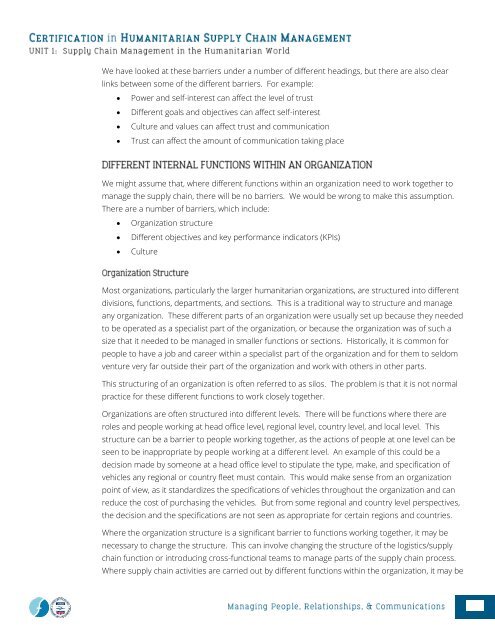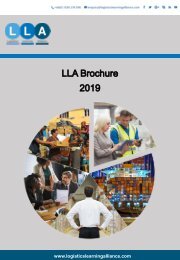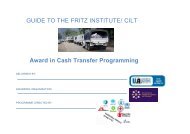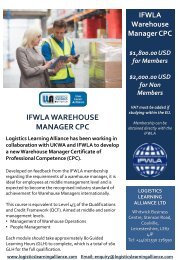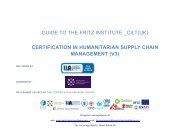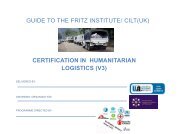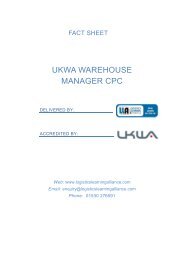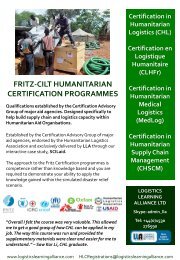CHSCM 3.0 - Unit 1 - SCM in the Humanitarian World
Learning Materials for Unit 1 of the Certification in Humanitarian Supply Chain Management (CHSCM).
Learning Materials for Unit 1 of the Certification in Humanitarian Supply Chain Management (CHSCM).
Create successful ePaper yourself
Turn your PDF publications into a flip-book with our unique Google optimized e-Paper software.
We have looked at <strong>the</strong>se barriers under a number of different head<strong>in</strong>gs, but <strong>the</strong>re are also clear<br />
l<strong>in</strong>ks between some of <strong>the</strong> different barriers. For example:<br />
• Power and self-<strong>in</strong>terest can affect <strong>the</strong> level of trust<br />
• Different goals and objectives can affect self-<strong>in</strong>terest<br />
• Culture and values can affect trust and communication<br />
• Trust can affect <strong>the</strong> amount of communication tak<strong>in</strong>g place<br />
We might assume that, where different functions with<strong>in</strong> an organization need to work toge<strong>the</strong>r to<br />
manage <strong>the</strong> supply cha<strong>in</strong>, <strong>the</strong>re will be no barriers. We would be wrong to make this assumption.<br />
There are a number of barriers, which <strong>in</strong>clude:<br />
• Organization structure<br />
• Different objectives and key performance <strong>in</strong>dicators (KPIs)<br />
• Culture<br />
Most organizations, particularly <strong>the</strong> larger humanitarian organizations, are structured <strong>in</strong>to different<br />
divisions, functions, departments, and sections. This is a traditional way to structure and manage<br />
any organization. These different parts of an organization were usually set up because <strong>the</strong>y needed<br />
to be operated as a specialist part of <strong>the</strong> organization, or because <strong>the</strong> organization was of such a<br />
size that it needed to be managed <strong>in</strong> smaller functions or sections. Historically, it is common for<br />
people to have a job and career with<strong>in</strong> a specialist part of <strong>the</strong> organization and for <strong>the</strong>m to seldom<br />
venture very far outside <strong>the</strong>ir part of <strong>the</strong> organization and work with o<strong>the</strong>rs <strong>in</strong> o<strong>the</strong>r parts.<br />
This structur<strong>in</strong>g of an organization is often referred to as silos. The problem is that it is not normal<br />
practice for <strong>the</strong>se different functions to work closely toge<strong>the</strong>r.<br />
Organizations are often structured <strong>in</strong>to different levels. There will be functions where <strong>the</strong>re are<br />
roles and people work<strong>in</strong>g at head office level, regional level, country level, and local level. This<br />
structure can be a barrier to people work<strong>in</strong>g toge<strong>the</strong>r, as <strong>the</strong> actions of people at one level can be<br />
seen to be <strong>in</strong>appropriate by people work<strong>in</strong>g at a different level. An example of this could be a<br />
decision made by someone at a head office level to stipulate <strong>the</strong> type, make, and specification of<br />
vehicles any regional or country fleet must conta<strong>in</strong>. This would make sense from an organization<br />
po<strong>in</strong>t of view, as it standardizes <strong>the</strong> specifications of vehicles throughout <strong>the</strong> organization and can<br />
reduce <strong>the</strong> cost of purchas<strong>in</strong>g <strong>the</strong> vehicles. But from some regional and country level perspectives,<br />
<strong>the</strong> decision and <strong>the</strong> specifications are not seen as appropriate for certa<strong>in</strong> regions and countries.<br />
Where <strong>the</strong> organization structure is a significant barrier to functions work<strong>in</strong>g toge<strong>the</strong>r, it may be<br />
necessary to change <strong>the</strong> structure. This can <strong>in</strong>volve chang<strong>in</strong>g <strong>the</strong> structure of <strong>the</strong> logistics/supply<br />
cha<strong>in</strong> function or <strong>in</strong>troduc<strong>in</strong>g cross-functional teams to manage parts of <strong>the</strong> supply cha<strong>in</strong> process.<br />
Where supply cha<strong>in</strong> activities are carried out by different functions with<strong>in</strong> <strong>the</strong> organization, it may be


